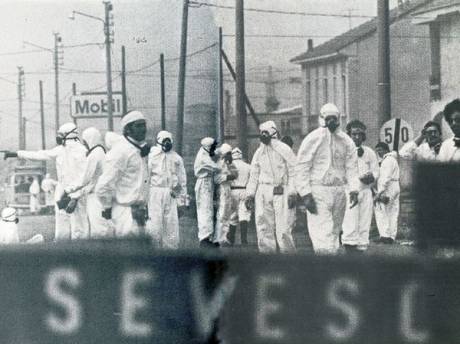Italy 1976: Seveso, Italy, saw one of Europe's worst environmental disasters
 international |
miscellaneous |
other press
international |
miscellaneous |
other press  Sunday August 25, 2013 00:01
Sunday August 25, 2013 00:01 by xxx
by xxx
Few industrial accidents can match the severity of the Seveso disaster of 1976. Despite the resulting long-term health problems and environmental risks, however, the accidental release of gases including TCDD -- a form of cancer-causing dioxin -- into a residential area of Italy had some positive legacies, including the creation of tighter environmental regulations and health protections throughout Europe.
A small suburban town some 10 miles north of Milan, Italy, Seveso had a population of about 17,000 in the 1970s. Other nearby cities include Desio, Cesano Maderno and Meda; together, these formed a mix of urban, residential and small farming areas. A local chemical plant, constructed many years earlier in Meda, was owned by ICMESA, a subsidiary of pharmaceutical giant Hoffman-La Roche.
Overall, the plant was not perceived as a threat by the local population. All that changed, however, on the afternoon of Saturday, July 10, 1976, as parts of the plant were being shut down for the weekend. While residents of Seveso and the surrounding area were tending their gardens, running errands or watching their children play, one of the buildings in the chemical plant was getting dangerously hot as cooling mechanisms were turned off.
When the temperature inside one of the plant's tanks reached a critical level, a pressure release valve opened, and about six metric tons of toxic gas were emitted from the facility. The resulting gas cloud that drifted over the Seveso area contained an estimated one kilogram of TCDD, technically known as 2,3,7,8-tetrachlorodibenzodioxin.
TCDD in Seveso
TCDD is one type of dioxin, a family of chemical compounds that are a by-product of industrial activities like bleaching wood pulp, incinerating garbage, metal smelting and chemical production. Dioxin is also present in small amounts in the herbicide Agent Orange, which was used throughout Southeast Asia during the Vietnam War.
Dioxin is universally recognized as a carcinogen (a cancer-causing agent). It's also known to cause reproductive, immune and developmental effects in mammals, and can cause severe liver problems in people exposed to high levels of the compound. Chloracne, a serious skin condition that resembles very bad acne, can also result from high exposures to dioxin.
Within a few hours after the ICMESA facility gas release, over 37,000 people throughout the Seveso area were exposed to unprecedented levels of dioxin. Among the first to suffer, however, were the area's animals. According to Time, "One farmer saw his cat keel over, and when he went to pick up the body, the tail fell off. When authorities dug the cat up for examination two days later, said the farmer, all that was left was its skull."
Despite their exposure to high levels of dioxin, it was a few days before people began to feel the effects: nausea, blurred vision, skin lesions and the development of severe chloracne, particularly among children. As a result of the slow development of symptoms, the area around Seveso was not immediately evacuated.
Dead animals, especially chickens and rabbits kept as food, began to overwhelm the city's resources, and many were slaughtered on an emergency basis to prevent people from eating them. (Dioxin accumulates in fatty tissue, and can be ingested by eating plants or animals that have been exposed to it.) By 1978, an estimated 80,000 animals were slaughtered.
The Legacy of Seveso
The response to the Seveso accident was widely criticized as slow and bungled. Several days passed before it was announced that a gas containing dioxin had been released from the facility; evacuation of the worst-affected areas took several more days.
Research into the long-term health effects of the Seveso disaster is ongoing. One study from 2008 found that babies born to women living in the contaminated area at the time of the accident were about six times more likely to have altered thyroid function than other babies. Additionally, a 2009 report found an increase in breast and lymphatic cancers in the area. However, other research into liver, immune, neurologic and reproductive effects yielded no conclusive information.
Seveso and its residents continue to function as a kind of "living laboratory" into the effects of dioxin exposure on people and animals. Throughout Europe, the name Seveso is now associated with tough regulations that require any facilities storing, manufacturing or handling hazardous materials to inform local authorities and communities about the nature of their facility, and to create and publicize measures to prevent and respond to any accident that may occur.
The ICMESA plant is now completely closed, and the Seveso Oak Forest park was created above the buried facility. Beneath the wooded park, however, sits two tanks that hold the remains of thousands of slaughtered animals, the destroyed chemical plant and the soil that had the highest degree of dioxin contamination.
via: http://greenliving.about.com/od/greenprograms/a/Seveso-...D.htm
